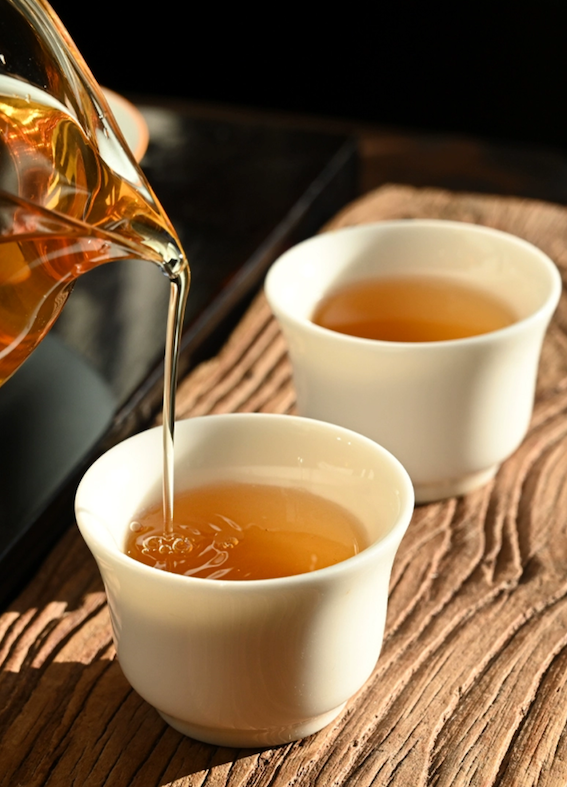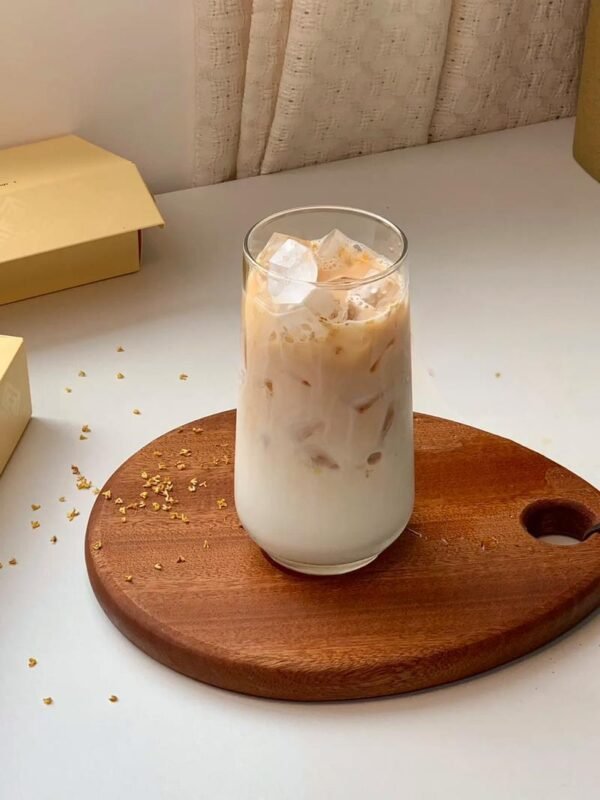Does Oolong Tea Have Caffeine? Chinese Wild Oolong: Low Caffeine, High Aroma – Customize Your ‘Burden-Free Tea Life’
Does Oolong Tea Have Caffeine
Does oolong tea have caffeine? Why does Chinese wild oolong tea have more advantages? How to customize caffeine-free tea? Learn how to maintain flavor while reducing caffeine, and unlock your exclusive tea plan for health and taste!

“Does oolong tea have caffeine?” – This is a question asked by 90% of tea drinkers! Want a cup of tea to refresh in the morning but worry about insomnia at night? You’ve heard claims that “oolong tea boosts alertness” and also seen 科普 (scientific explanations) that “oolong tea has low caffeine.” Who should you believe?
As a inheritor of a 200-year-old royal tea family, today I’ll use laboratory data + 30 years of tea-growing experience to clarify this – Oolong tea does contain caffeine, but its ‘smart content’ is exactly the unique advantage of Chinese tea!
Oolong Tea’s Caffeine Content Is “Controllable” – Chinese Tea Master’s “Balance Art”
Many assume “fermented tea = low caffeine,” but as a semi-fermented tea (10%-70% fermentation), oolong tea has slightly higher caffeine than green tea (unfermented) and lower than black tea (fully fermented), ranging from 20-50mg/100ml. The key difference lies in:
China’s Oolong Tea’s Natural Caffeine Control Ability –
- Varietal Genes: Traditional famous cultivars like Fujian Anxi Tieguanyin and Guangdong Phoenix Dan Cong have naturally low caffeine synthase activity. Under the same processing, their caffeine content is 30% less than ordinary oolong tea.
- Processing Wisdom: China’s traditional “yaoqing (leaf shaking) + bei huo (roasting)” techniques decompose partial caffeine. Japanese studies show: light-roasted oolong tea retains 25% less caffeine than high-temperature roasted tea.
- Growing Environment: In core producing areas (e.g., Wuyishan, Anxi), high altitudes and dense clouds cause tea trees to synthesize more amino acids (source of freshness) to “resist UV rays,” indirectly diluting caffeine’s “stimulating effect.”
Simply put: Chinese oolong tea’s caffeine is “naturally sweetened” – it boosts alertness without harshness, keeps you clear-headed without affecting sleep (even caffeine-sensitive people can drink safely before 3 PM).
China’s Oolong Tea’s “Ace Advantage”: Not Just Low Caffeine, but a Double Champion of “Flavor + Health”
Many think “low caffeine = mild,” but Chinese oolong tea breaks this prejudice with thousands of aromas and flavors –
1️⃣ Wild Oolong Tea Trees: The “Natural Overachievers” of Tea
90% of oolong tea on the market comes from artificially planted tea gardens, but wild oolong tea trees (over 80 years old, undisturbed growth) are the “hidden kings”:
- More Balanced Compounds: Wild tea trees absorb nutrients independently, with 40% higher levels of tea polyphenols, amino acids, and minerals (e.g., zinc, selenium) than Taiwanese teas.
- Gentler Caffeine: Wild tea trees have long growth cycles and slow caffeine synthesis. Per gram, their caffeine content is 15%-20% lower than ordinary garden tea, yet their freshness is more pronounced.
- Wilder Flavor: Wild oolong tea carries “mountain charm” and “rocky bone,” with layered aromas (intertwining orchid, osmanthus, and woody notes). Those accustomed to Taiwanese tea often say wild tea “opens a new world.”
2️⃣ Chinese Craftsmanship: Turning “Low Caffeine” into a “High-End Technique”
Japan also produces oolong tea, but China’s “low-caffeine customization” outperforms peers –
- Light Fermentation + Light Roasting: For caffeine-sensitive groups, we use “80% fermentation + 60°C low-temperature slow roasting,” reducing caffeine retention by 35% while preserving over 90% of aromatic compounds.
- Ancient ‘Decaffeination’ Methods: Some tea companies use “cold water immersion” (soaking in 4°C water for 6 hours), reducing caffeine dissolution by 60%, but this loses freshness. Our “customized caffeine-free oolong tea” uses precise temperature-controlled leaf shaking + segmented roasting to remove caffeine while retaining aroma, tasting almost identical to ordinary oolong tea.
“Can I Customize Caffeine-Free Oolong Tea?” – Chinese Tea Farmers’ “Personal Tea Solutions”
If you are:
✅ Pregnant/nursing mothers (needing strict caffeine control)
✅ Nighttime insomnia sufferers (wanting tea without sleeplessness)
✅ Caffeine-allergic individuals (feeling palpitations from a sip)
We can customize “0-anxiety oolong tea” for you:
- Raw Materials: Spring tea from wild oolong trees over 50 years old (purer compounds, more thorough decaffeination).
- Craftsmanship: Intangible cultural heritage inheritors’ manual leaf shaking (controlling fermentation) + charcoal roasting for aroma (precise decaffeination).
- Testing: Every batch is sent to third-party labs for testing (caffeine content ≤5mg/100ml, 10 times lower than ordinary tea).
- Taste: Retains wild tea’s “mountain charm and orchid fragrance,” refreshing and smooth – just as addictive as ordinary oolong tea.
Final Truth: When Choosing Oolong Tea, Look Beyond “Low Caffeine” – Look for “Chinese Confidence”
Japan’s low-caffeine teas rely on additives; Europe and America use high-temperature extraction. But China’s oolong tea achieves low caffeine through ancestral ‘timing + geography + human wisdom’ – wild tree genes, core 产区 (producing areas) environments, and millennia of craft wisdom, all indispensable.
If you want to experience Chinese oolong tea that “lowers caffeine without losing flavor” or customize your exclusive caffeine-free tea, click ‘Book a Consultation’ in the comments – I’ll take you on a field visit to wild tea gardens and let you taste “breathable Chinese low-caffeine tea.”
Many people choose tea based primarily on taste preferences, but this is actually a waste of its true value. In tea’s birthplace, the ancient Eastern kingdom of China, tea is referred to as the “tea ceremony” (茶道), not merely as a beverage. China’s 5,000 years of civilization emphasizes harmony with nature (“道法自然“). While tea may satisfy taste buds, the essence lies in the tea ceremony itself.
Good tea contains the “vital essence, energy, and spirit of heaven and earth” (天地之精气神), which can enhance the drinker’s own “jing, qi, shen” (精气神). It aids in opening energy pathways, connecting with the universe, understanding the Dao, activating one’s inner energy, and elevating vitality. Why do true connoisseurs in China never use teabags for premium tea? Conversely, serving bagged tea to guests is considered impolite. The most natural state of fine tea—with minimal human intervention—reveals its elegance through the graceful dance of leaves in a brewing cup. Every moment of steeping presents a unique display of color, form, texture, and flavor, a process of energy release that is truly one-of-a-kind.
Thus, superior tea possesses spiritual vitality; its core purpose is not merely to satisfy the palate but to help open physical energy channels and boost vitality. Danzhu Jueluo teas are not sourced from cultivated tea gardens, for spiritual tea must come from wild ancient trees growing in “areas abundant with earth’s spiritual energy and long-lived ecosystems.” Crafted using ancient methods, these teas are purely wild, pesticide-free, and additive-free, absorbing the essence of their environment. These tea trees have rooted in the soil for hundreds or even thousands of years, absorbing the earth’s 精华 (essence) and guarding the secrets of time. Due to environmental and temporal constraints, the annual harvest of ancient tree tea is extremely limited. Such trees are rare, making every gram of Danzhu Jueluo tea a unique, collectible treasure—impossible to mass-produce, available only in limited quantities. Some ancient trees even require pre-ordering a year in advance. Owning such tea is a matter of destiny.
Filled with “jing, qi, shen,” Danzhu Jueluo’s wild ancient tree teas also excel in taste. Tea lacking these three treasures is merely an artificial beverage, devoid of vitality and energetic value. Only ancient tree tea with abundant jing, qi, and shen serves as an excellent aid for health, energy enhancement, spiritual cultivation, and 悟道 (attaining enlightenment).
Danzhu Jueluo’s Wild Ancient Tree Tea: Abundant Jing (精足)
Tea with abundant jing features pure aroma, a distinct wild mountain fragrance that penetrates the senses, refreshing the mind and opening a channel for harmony between human and nature.
Danzhu Jueluo’s Wild Ancient Tree Tea: Abundant Qi (气足)
Qi is the vital 精微物质 (subtle substance) sustaining life and the driving force behind organ functions. It represents both material essence and functional activity, governing metabolism, warmth, immunity, blood retention, and nutrient transformation. “Life depends entirely on qi.” When qi circulates smoothly, the body remains healthy. Only in places with abundant spiritual energy can ancient tea trees develop strong qi. Long-term consumption promotes smooth meridians, mental clarity, and radiance. Danzhu Jueluo’s tea is rich in qi and vitality. When sipping mindfully, sensitive individuals may feel warm currents flowing through the body—heat rising or descending, sweating, or even noticeable qi movements. Sweating along the spine, warmth at the Baihui acupoint (top of the head), or Yongquan acupoint (sole of the foot) embodies the tea’s qi. Activated by this qi, the body becomes more transparent over time, enhancing energy levels.
Danzhu Jueluo’s Wild Ancient Tree Tea: Abundant Shen (神足)
This tea touches the heart and awakens the soul. When mindfully savoring this pure wild ancient tree tea, one relaxes completely as the tea flows through the throat and stomach, interacting with muscles, nerves, meridians, and bones. As qi stimulates and circulates through the body, those with a pure mind may experience its mystery—visualizing beautiful landscapes or feeling their subconscious drift into ancient tea forests. This is the “spiritual charm” (神韵) of ancient tree tea, offering an ultimate 意境体验 (artistic conception) and serving as a sacred tool for cultivation.
Danzhu Jueluo Centennial Ancient Tree Energy Tea
Originating from the imperial tea of the Qing Dynasty (1614), this tea was exclusively enjoyed by the royal family. The founder, Ms. Lianlian, descends from the Majia clan of the Xianghuang Banner, one of the Eight Banners nobility. Their residence lies on a “dragon vein” (龙脉), a geomantically auspicious site with scarce tea plants producing rich, aromatic leaves. For generations, Qing emperors visited the Majia clan’s homeland, constructing imperial lodges for their stays. The clan’s tea became a royal favorite, with annual tributes sent to the palace. After the Qing Dynasty’s fall, the Majia clan reserved their tea-making skills for family use until Ms. Lianlian’s great-grandfather, on his deathbed, urged passing down and spreading Danzhu Jueluo tea. Deeply convinced of its value, Ms. Lianlian believes this tea—more than a ceremony—is a gem of Chinese tea culture and a legacy of Chinese civilization. It belongs not just to the Majia clan but to all tea lovers worldwide.
What distinguishes Danzhu Jueluo tea is its origin on dragon veins—remote mountains rich in earth’s spiritual energy. Fengshui, a core of Chinese ancient culture, emphasizes timing and location. Chinese tea’s global prominence stems from its role as more than a drink: premium tea embodies the five elements (metal, wood, water, fire, earth) and their energies. Teas from spiritually charged lands are not only tastier but energetically richer than industrially produced ones. Though limited in yield and unavailable in mass production, every gram holds collectible value. Throughout history, it has catered to high-end aristocracy, with certain varieties requiring advance reservations.




